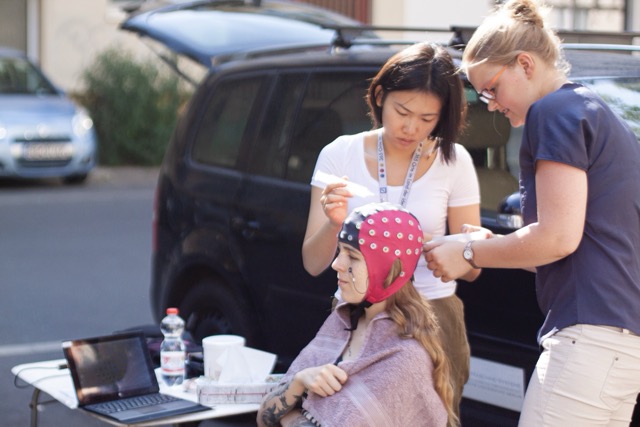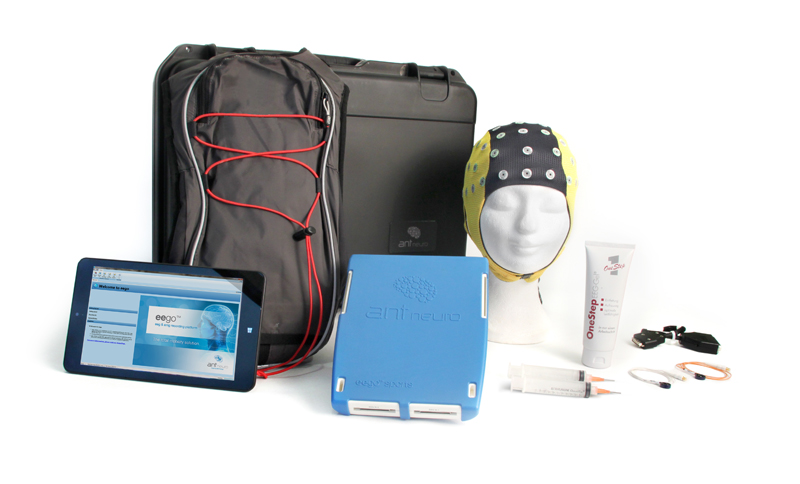Wunderlich’s study shows that landmark-based auditory instructions improve spatial learning and brain responses in real-world navigation. Mobile EEG confirmed these effects outside the lab. ANT Neuro’s eego™sports made this research possible.
Investigating the impact of auditory navigation instructions upon incidental spatial learning in pedestrians

Professor Klaus Gramann is the Head of the Department of
Biological Psychology and Neuroergonomics at the Berlin Institute of
Technology in Berlin, Germany, and founder of the Berlin Mobile Brain
/ Body Imaging Lab (BeMoBIL). He is also on the International Faculty
at School of Software, University of Technology Sydney, Australia, and
at the Center for Advanced Neurological Engineering, University of
California, San Diego.

Anna Wunderlich is a PhD student at BeMoBIL, whose work focuses
on identifying neural and behavioral processes underlying natural
cognition. She obtained her Masters degree in Human Factors at
TU Berlin in 2016 and Bachelors degree in Sensoric and Cognitive
Psychology at TU Chemnitz in 2013. Hereafter, she joined the laboratory
of Prof. Klaus Gramann in 2017 as a PhD candidate. Her thesis focuses
on spatial knowledge acquisition during assisted navigation comparing
landmark-based and standard navigation instructions.
Introduction
Smartphones have become a standard utensil in the vast majority of everyone’s daily life. Importantly, it has become rather customary to employ smartphones when having to navigate within novel environments. In fact, Navigation Assistance Systems (NAS) are used extensively by pedestrians and vehicle operators alike. While this technological revolution provides a remarkable tool for everyday spatial exploration, there has been a growing body of work focusing on the impact of NAS upon perception and interaction with the environment. More specifically, Wunderlich and colleagues aim at investigating the impact of NAS on the neurophysiological mechanisms underpinning spatial cognition in general and incidental spatial learning in particular.
The interest of the BeMoBIL to further explore the impact of NAS on spatial cognition was driven by prior studies suggesting that excessive use of NAS technology leads to a decrease of orienting abilities (Münzer, Zimmer, Schwalm, Baus, & Aslan, 2006). In fact, several studies have shown that the use of visual-based NAS interferes with visuo-motor spatial processing during navigation (resulting in an automation bias) due to the increase in attentional demands (e.g . Lin, Kuehl, Schöning, & Hecht, 2017). Ultimately, this results in the over-reliance on the NAS by the user in order to cope with the increased cognitive demands and, consequently, to diminished spatial processing (Fenech, Drews, & Bakdash, 2010).
Interestingly, auditory-based NAS seem to be beneficial for spatial navigation, and to interfere less with visuo-motor processes (May & Ross, 2006; Wunderlich & Gramann, 2018). Further, Gramann and colleagues (2017) showed that auditory navigation instructions could improve incidental spatial learning when landmarks were augmented in a virtual driving task (Gramann, Hoepner, & Karrer-Gauss, 2017, Wunderlich & Gramann, 2018). Here, Wunderlich and Gramann investigated how auditory NAS instructions affect spatial navigation and subsequent spatial memory trace retrieval within real-world settings.
Premise
The findings from Gramann and colleagues (2017, 2018) provided initial and compelling results suggesting beneficial incidental learning effects following enhanced auditory navigation instructions. Nonetheless, these data were acquired within a controlled laboratory setup. Whether these findings can be directly transposed to real-world settings was still to be addressed.
Materials & Methods
22 participants were asked to navigate through a novel environment by following auditory navigation instructions. While participants followed a pre-defined path, simultaneous EEG from 64 channels was recorded (see Figures 1 and 2). Participants were subdivided into two groups. While one group received standard navigational instructions, subjects in the second group received long, more detailed auditory instructions. More specifically, subjects in the standard group were prompted to (e.g.) “Turn left at the next intersection”. Alternatively, subjects in the long instruction group received landmark-based instructions such as “Turn left at the UdK. The UdK is the biggest University of Arts in Europe.”
Upon completion of the pedestrian route,
all participants were brought back to the
BeMoBIL where they were asked to draw a
map and complete a cued-recall task. The
latter entailed that the subjects were asked to
indicate route directions according to images
of landmarks. These landmarks could 1) be
novel items, 2) have been encountered during
straight segments of the route, or 3) have been
encountered at intersections of the route.
 Figure 1: Subject preparation
Figure 1: Subject preparationResults
The results replicated prior findings, suggesting that landmark-based navigation instructions enhance incidental spatial learning (Gramann et al., 2017; Wunderlich & Gramann, 2018).
Interestingly, the results also suggested
that the more detailed content presented
to the “long instruction” group, significantly
increase subsequent landmark recognition
performance. These differences observed
at the behavioral level were also reflected at
the neurophysiological level. In fact, blinkrelated
responses during navigation showed
greater amplitudes over frontal electrodes as
compared to standard navigation instructions.
 Figure 2: Mobile EEG recording
Figure 2: Mobile EEG recordingNew avenues for data processing
Importantly, the work from Wunderlich and colleagues provides exemplar insight into the analytical challenges related to EEG data acquired in real-world settings. Specifically, the present study was conducted in freelymoving participants navigating within the real world. Compared to classical laboratorybased paradigms, where analysis pipelines capitalize upon the extraction of epochs based on well-controlled events/triggers in time, no such stimulus control was applied within the paradigm at hand. Consequently, the analysis of such data poses a technical and methodological challenge. Rather, EEG segments were extracted with respect to Eyeblinks (bERPs) or saccades (sERPs). The rationale behind this approach is that, in the absence of controlled visual stimulus presentations, eyeblinks and saccades can be considered as natural indices for the onset of novel information delivered to the visual system.
For a full account of the methods employed
we would like to refer you to Wunderlich &
Gramann (2020).

Blink‐related potentials during the presentation of navigation instructions. Left panel displays the topography of the activity averaged across three time windows of 250ms. Top row represents the standard and bottom row the landmark-based navigation instruction condition. Right panel shows the blink-related potential at FCz. Baseline correction was done by subtracting the average activity of ‐400 to ‐200 ms. Grey areas represent time windows where samplewise significant differences were found between the two navigation instruction conditions. Positivity is plotted upwards.
Outlook
Studies such as the here presented work by Wunderlich and colleagues can further our understanding of how the brain integrates and processes information in real-world settings. This is of crucial importance when trying to bridge the gap between findings stemming from laboratory settings to the neurophysiological underpinnings of realworld exploration. The striking advancements made in recent years within the field of hardware engineering have provided researchers with the necessary tools to acquire high-quality electroencephalographic data within real-world settings. As such, ANT Neuro is proud to contribute to such enticing research avenues through the provision of high-density EEG systems for mobile data acquisition.
Overcoming challenges of EEG recordings
in Real-World settings
The investigation of neurophysiological processes in real-world settings has long-time been a major limitation factor for cognitive neuroscientists. This mainly stemmed from the lack of the availability of portable, light-weight, high-density EEG systems. Additionally, noise contamination of the EEG signal through ambient electromagnetic interference as well as mechanically induced noise transients (e.g. cable displacement) have long-time hindered a straight-forward translation of EEG setups from the laboratory into the real-world. Ultimately, the availability of analysis pinelines and computational tools, capable of effectively extracting neural activity from concurrently elicited physiological signals (e.g. muscle activity) has been a milestone within the past years. The ANT Neuro eego™sports solution employed here, provides a ultra-light 64-channel amplifier which conveniently fits into a dedicated backpack. Data were recorded throughout the length of the task on a high-performance tablet placed within the backpack. Furthermore, the active shielding technology implemented between the eego™ amplifier and the waveguard™ original 64-channel electrode caps effectively counteracted interference of electromagnetic and mechanical noise sources. The current study underlines the effectiveness and outstanding EEG signal quality which can be achieved with the ANT Neuro eego™sports solution.

eego™sports ultra-mobile EEG & EMG recording solution
References

The Effects of Acoustic Turn-by-turn Navigation on Wayfinding
by Fenech, E. P., Drews, F. A., & Bakdash, J. Z. (2010).
Read More
Modified Navigation Instructions for Spatial Navigation Assistance Systems Lead to Incidental Spatial Learning
by Gramann, K., Hoepner, P., & Karrer-Gauss, K. (2017).
Read More
Understanding "Death by GPS": A Systematic Study of Catastrophic Incidents Associated with Personal Navigation Technologies
by Lin, A. Y., Kuehl, K., Schöning, J., & Hecht, B. (2017).
Read More
Presence and Quality of Navigational Landmarks: Effect on Driver Performance and Implications for Design
by May, A. J., & Ross, T. (2006).
Read More
Computer-assisted navigation and the acquisition of route and survey knowledge
by Münzer, S., Zimmer, H. D., Schwalm, M., Baus, J., & Aslan, I. (2006).
Read More
Electrocortical Evidence for Long-Term Incidental Spatial Learning Through Modified Navigation Instructions
by Wunderlich, A., & Gramann, K. (2018).
Read More
Eye movement-related brain potentials during assisted navigation in real-world environments
by Wunderlich, A., & Gramann, K. (2020).
Read More